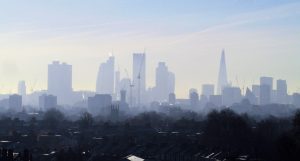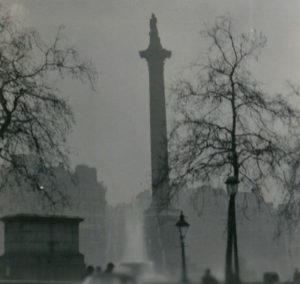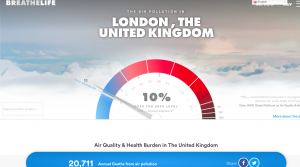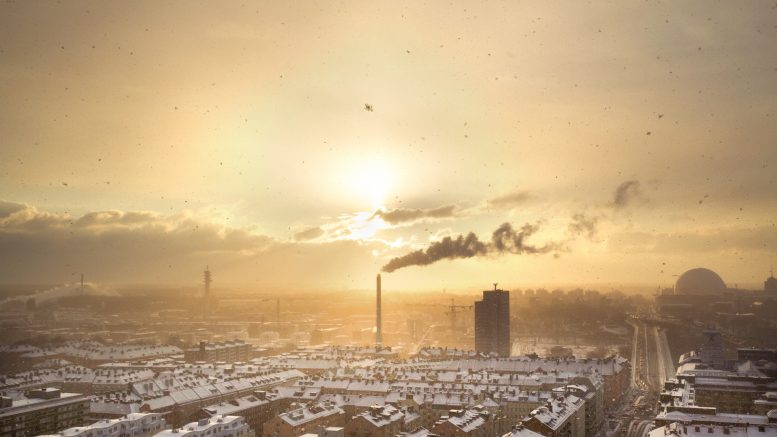66 years on from London’s toxic Great Smog and despite the growing amount of research and attention focused on air pollution, this still remains a concerning issue worldwide.

Photo credit: David Holt – Flickr
A brief look on the London Great Smog
It was the 5th of December 1952 when a thick, yellow fog left London in a virtual standstill for four days and entered the history pages of what today is known as the Great Smog.
People were using low-quality sulphurous coal to stay warm and around the same time an anticyclone was hanging over London which resulted in keeping the cold air trapped as well as the chimney smoke close to the ground.
With visibility reduced to just a few yards, effects of the smog included major disruption to public transport, emergency services and outdoor sports events. Experts estimate the smog claimed at least 8,000 lives, and perhaps as many as 12,000.

Capture from the 1952 London Great Smog Photo credit: N.T. Stobbs via Wikimedia Commons
That led to the Clean Air Act of 1956 to be passed in Parliament which restricted the burning of coal in urban areas and access to alternative heating systems such as gas fires. However, the transition toward gas, oil and electricity hasn’t come into effect that quickly and other deadly fogs occurred, yet none at the scale of the 1952 Great Smog.
What has changed since then?
Nowadays, coal pollution may not represent a reason of concern, but that doesn’t mean the air quality has improved. In fact, coal pollution has been replaced by “invisible pollution”, as shown in some stats found by IPPR, the Progressive Policy Think Tank:
- In London, approximately 50 per cent of air pollution comes from road transport and 40 per cent comes from diesel.
- 6m car journeys are made by Londoners every day (2m of those are under 2km).
A recent report conducted by King’s College London on the Medical Effects of Air Pollutants (COMEAP) shows that every year in the UK up to 36,000 people die as a result of air pollution.
According to the World Health Organization (WHO), 90 per cent of people breathe unsafe air and consequently, air pollution is also responsible for seven million early deaths every year.
Cities can take action to improve air quality if they reduce 25% of transportation-related black carbon emissions by choosing cleaner fuels and engines for their bus fleets. #BeatAirPollution pic.twitter.com/nEAPlZFLar
— UN Environment Programme (@UNEP) October 19, 2018
What is it to be done?

“I want London to be a world leader in how we respond to the challenge of cleaning up our air,” said Sadiq Khan in a statement in 2016.
Since then, the London Mayor has proposed a series of actions to combat air pollution in the capital:
-
Toxicity Charge (T-Charge) – £10 toxicity fee for older, more polluting vehicles, mainly diesel and petrol ones registered before 2006, but also later models.
-
Ultra Low Emission Zone (ULEZ) – set to be launched in April 2019, looking to tighten the emission standards for diesel vehicles.
- Cleaner Vehicle Checker – it shows the levels of nitrogen oxides (NOx).
£6 million is now accessible for London councils to address pollution in their area.
We look forward to working with councils such as Walthamstow, who are already seeing the benefits of working with City Hall, local businesses and schools to clean the air in Waltham Forest. pic.twitter.com/vpzDvgRgZk
— Mayor of London, Sadiq Khan (@MayorofLondon) September 27, 2018
Progress on air pollution is already being made in other countries across the globe.
Let’s take China for example, heavily criticised for the alarming levels of pollution there.
Four years ago, President Xi has declared a war on pollution after the country has been labelled as the largest emitter of greenhouse gases, including carbon dioxide and particle PM 2.5 (the worst of the air-borne pollution particles that can cause deaths from heart attacks, cancer, asthma among other health risks).
Since then, China has made the biggest investment in clean energy and is yet to become a global leader in renewable energy. Greenpeace announced in its most recent report at the beginning of the year that the levels of PM 2.5 fell 35% in 74 cities across China. Nationwide, about 160,000 premature deaths were avoided in 2017 due to the reduction in pollution.
To combat smog pollution, China is building tower block forests that produce 60kg of Oxygen a day and absorb 25 tons of Carbon Dioxide a year. #china #pollution #Tech #Construction #Architecture #Innovation #Sustainability #environment #MondayMotivationpic.twitter.com/0R5jV96la2
— CIS (UK) Ltd (@CISGroupUK) November 19, 2018
What can you do on an individual basis?
The World Health Organisation and UN Environment have created a global campaign, BreatheLife, aimed to mobilise cities and individuals to protect the planet.
'[Air Pollution is] the new tobacco' 🚬
The air quality life index calculates that air pollution cuts average life expectancy per person by 2 years. This is a matter of life or death. Let's start treating it as such. #BreatheLife #BeatAirPollutionhttps://t.co/eHJujcUBA5 pic.twitter.com/RnNcReo3m6— UN Environment Programme (@UNEP) November 21, 2018
Words: Teodora Agarici | Subbing: Maria Campuzano
Featured image: Photo by Petter Rudwall on Unsplash

